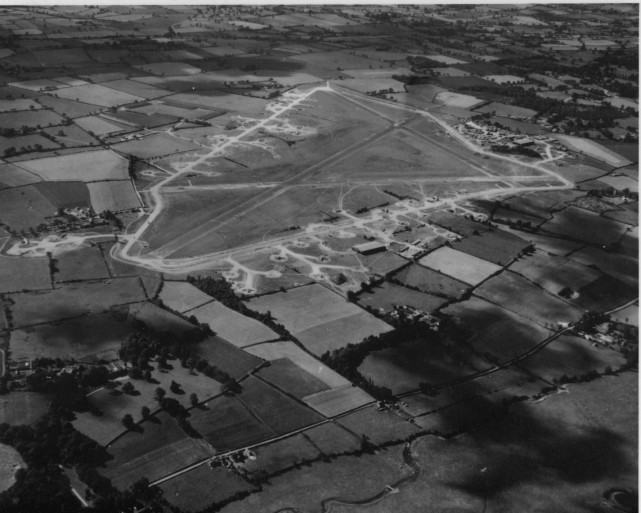
FLIXTON AIRFIELDSTATION 125Set on a plateau above the Waveney Valley about two miles south of Bungay and just beyond the village of Flixton, is the site of Bungay airfield. Initially allocated to the Eighth Air Force on 4th June 1942 as a bomber base, Bungay was constructed by Kirk & Kirk Ltd, and given the US Station number 125. When finally completed in April 1944, the airfield had three intersecting runways measuring, 05-23 at 6000 feet (main), 10-28 at 4440 feet and 00-18 at 4200. The airfield also comprised two T2 hangars, 50 hard stands, HQ. site, technical site, sick quarters, 4 Defence sites, 8 communal sites and 1 W.A.A.F. site.
The field was first used before completion, in October/November 1942 by B-25C Mitchells of 428 Bomb Sqn of the 310th BG, followed on 3rd December by 329 Sqn of the 93rd BG (Ted’s Travelling Circus - named after the CO, Colonel Ted Timberlake, which flew B24 Liberators. This squadron was detached to Bungay from the Group’s base at Hardwick for ‘Moleing’ operations and to evaluate GEE - the radar navigation device. ‘Moleing’ was the code name given to sorties by individual aircraft with the object of causing maximum destruction to enemy industrial production. Many sorties had to be aborted due to insufficient cloud cover, which was an essential requirement for this type of operation. In March 1943, 329 Sqn rejoined its parent group at Hardwick which in the meantime had been doing a stint of operations in North Africa.
Flixton Airfield 1944 Bungay’s main residents were the 446th BG (Heavy) which gained the nickname "The Bungay Buckaroos". This group first touched down on 4th November 1943, after flying the Southern Ferry Route across the Atlantic. Commanded by Colonel Jacob J Brogger, this group had four squadrons of B-24 Liberators - the 704th, 705th, 706th and 707th - which, together with the 93rd BG at Hardwick and the 448th at Seething made up the 20th Combat Wing of the Second Bombardment Division, 8th US Air Force. After warming up, the 446th’s first mission was flown on 16th December 1943, when the target was Bremen. On returning, two B-24s crash landed on or near base and were written off. This was followed by a mission to Osnabruck on 22nd December, when the first losses were sustained over enemy territory. The 446th Group’s last raid was flown on 25th April 1945, by which time they had clocked up 273 combat missions during which they delivered 16,800 tons of bombs. Total losses amounted to 58 aircraft in action, and 28 due to other operational causes. The Group left for the USA in July of the same year. 446BG On 20th July 1945, RAF No. 42 Group took over responsibility for the airfield and was allocated to 53MU.
The airfield was transferred to the Fleet Air Arm and commissioned as HMS Europa II on 25th September 1945 as an intended satellite of HMS Sparrowhawk (Halesworth), under the control of HMS Europa at RN Lowestoft. It was paid off on 31st May 1946, however, and taken back by the Air Ministry.
Authority was given w.e.f. 24th November 1947 for the transfer of the sub-sites at Bungay and Seething from 53MU to 94MU, which had its HQ at Great Ashfield. Stored on the runways and in the buildings, were 250 lb., 500 lb., 2000 lb., and 4000 lb. bombs, balloon cable cutting cartridges, depth charges, 7" parachute flares and German ammunition. The latter two items were eventually taken to 53 MU, Pulham, and destroyed there. By February 1950, the airfield became No1 Sub-Site of 53MU, and was then progressively run down until closure in 1955. The final station board from the main gate is displayed in the first hangar along with a selection of photographs. In later years, the airfield was the base of the Martlesham Heath Parachute Club, with Cessna 182 G-ATNU and crop sprayers, including Pawnee D G-BFRY. In 1981-82, the Flixton Church Roof Restoration Fund held mini air shows. The first, on 27 September 1981, brought the following visitors: Nipper G-AVAC, Condor G-AWSN, Cessna Skyhawk G-SKYH, Cessna 152 G-BGAF, Rallye G-AYLE, and Cubs G-BHHV and G-BCNX. In 1982, David G Cook designed a microlight called Shaddow. an aircraft that has been described as the best microlight in the world. This was first flown and tested on the airfield and in 1983, took the FAI World Speed and distance records for the class. In 1987 it won the British Design Award. Of the airfield itself, most of the wartime buildings, including the control tower and hangars, have long since been demolished. Until 1983, the main runway and peritrack were in good condition, but the following year work started on breaking them up. In the spring of 1986 a new set of oak gates were hung at St Mary’s Church, Flixton, which stands close to the old airfield. These were bought as a result of donations by veterans of the 446th BG to replace those originally presented in 1945 by the Americans at Flixton. A small memorial plaque carries the inscription, "These gates were presented in memory of the men of the 446th Bombardment Group, USAAF, who gave their lives in the defence of freedom, 1941-1945". |
|||||||||||
|



